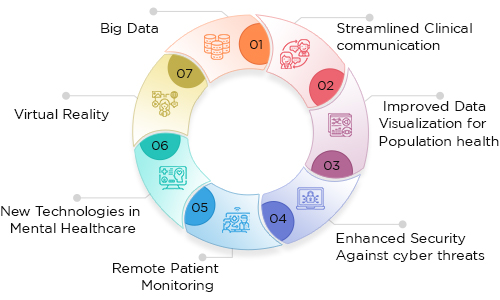Introduction
Increased digital healthcare investments highlight the latest healthcare IT trends. As per the 2021 Future of Healthcare Report, almost 80% of healthcare systems plan to increase investment in health technology.
There has been a high demand for custom medicine and growing pressure to reduce healthcare costs. The COVID-19 pandemic has had a significantly incredible impact on healthcare digitalization. Therefore, it is expected that more healthcare providers will lean towards modern technologies in the upcoming years. Hospitals, health systems, and patients continued to embrace evolutions in technology in healthcare this year while maintaining steady industry growth and adaptations to new challenges.
Top 7 trends in health information technology for 2023

Here are seven healthcare technology trends to watch for next year, from digital health advancements to innovation and cybersecurity in the future of healthcare in 2023.
1. Big Data
Big data in healthcare implies the large amount of information developed by adopting the latest healthcare technologies that collect patients’ medical records. It can be utilized for many purposes, from curing individual patients to predicting. This information technology in healthcare is transforming the medical industry. The biggest healthcare systems in the future will use devices that monitor patients’ well-being and help medical experts provide high-quality care with health information technology. Big data in the global healthcare market is expected to reach $34.27 billion by 2023 end at a CAGR of 22.07%. The big data analytics segment will be worth around $68.03 billion by 2024.
2. Streamlined Clinical communication
More healthcare organizations implement solutions that facilitate real-time access to patient information and seamless collaboration among care teams. Streamlining communication in information technology involves reducing the steps required for receiving data and implementing health analytics. If done correctly, streamlined communication can lead to a better patient care approach by delivering the right message to the right person in real-time.
3. Improved data visualization for population health
The right tools for future trends in healthcare can streamline the development of actionable, data-informed insights. However, doing so under rapidly transforming circumstances for population health management is challenging. That is why providers and researchers move toward digital health trends as they take advantage of both technology and partnerships. In the process, they are striving to enhance care delivery, including integrated care or collaborative care and increasing patient engagement. Simplifying patient medical records through data visualization enables nurses to interpret research and leverage their information with healthcare trends easily. Healthcare IT trends of better data visualization can also allow healthcare providers to access electronic health records while maintaining HIPAA compliance.
4. Enhanced security against cyber threats
Another popular healthcare IT trend is better health informatics and electronic data exchange security. Hospital and health systems navigated escalating cybersecurity threats in healthcare tech trends as the medical industry faces increasing cyber threats with telehealth and other emerging trends in health IT. Since the onset of COVID-19, cyberattacks have become frequent. The healthcare technology trends need to integrate better security to mitigate threats, even small ones as phishing attempts.
5. Remote Patient Monitoring
A remote patient monitoring system provides an healthcare interoperability patient engagement platform that promotes better patient-provider communication and manages complex health conditions. Physicians provide their patients with wearable devices to help them monitor their health remotely at home. These measure patient vitals, analyze their health data, and remind patients to take their medications, thereby offering patient engagement solutions. Like mHealth, remote patient monitoring also helps healthcare institutions to save on time and expense and deliver high-quality healthcare without meeting patients in person. Remote patient monitoring solutions can greatly improve health access in areas where quality healthcare is difficult to receive. This technology in healthcare promotes health equity, increases patient satisfaction, and improves the ROI generation of healthcare providers.
6. New Technologies in Mental Healthcare
Healthcare IT trends for 2023 will see a surge in demand for automated healthcare mobile solutions for mental health. These cloud-based healthcare technologies will define the health IT trends in video game treatment, smartphone-assisted therapy, and online symptom tracking. A video game solution called EdeavorRx can work with young patients aged 8-12 years to improve their attention problems. It can be combined with medication, physician-directed therapy, and educational programs for improving a person’s well-being.
When it comes to smartphone-assisted therapy in information technology and healthcare, it will become increasingly popular in 2024. Many chatbots and mobile apps would be launched for information technology management to utilize patients’ voice and speech patterns to indicate signs of emotional instability. Online symptom tracking information technology would allow patients to report their symptoms daily, improving and fastening the recovery process. Mental health professionals can have 24/7 access to health and information technology updates. This implies that providers can develop treatments based on the health data received from patients daily using health information technology.
7. Virtual Reality
Among the technology trends in healthcare, virtual reality has revolutionized the healthcare sector by improving patient recovery time and hospital management. VR headsets are used for medical training purposes for enabling training in a different environment. It can also be applied for treating patients undergoing complex surgery planning, such as neurosurgical procedures. Considering information technology trends in healthcare, VR sets can help people with developmental disorders and improve their coping mechanisms. This healthcare technology can also simulate surgeries for error reduction by training doctors and enhancing their skills.
Conclusion
These healthcare IT trends are steadily getting more attention and will soon take over the healthcare industry. Healthcare companies need software developers and engineers to integrate health IT trends. Since 2023 is here, and the healthcare technology trends start now, OSP can help you transition to value-based and patient-centred care. Our experienced software developers provide an extensive list of services and create custom health IT solutions. We have many years of experience building different types of healthcare technology solutions, such as patient portals, practice management solutions, health management tools , etc.
OSP is a trusted software development company that delivers bespoke solutions as per your business needs. Connect with us to hire the best talents in the industry to build enterprise-grade software.

How can we help?
Fill out the short form below or call us at (888) 846-5382
Looking for software solutions to build your product?
Let's discuss your software solutions for your product in our free development acceleration call!
Get In Touch arrow_forwardDiscuss Your Project Handover with a team of expert Book a free consultation arrow_forward
About Author

Written by Riken Shah linkedin
Riken's work motto is to help healthcare providers use technological advancements to make healthcare easily accessible to all stakeholders, from providers to patients. Under his leadership and guidance, OSP Labs has successfully developed over 600 customized software solutions for 200+ healthcare clients across continents.

















